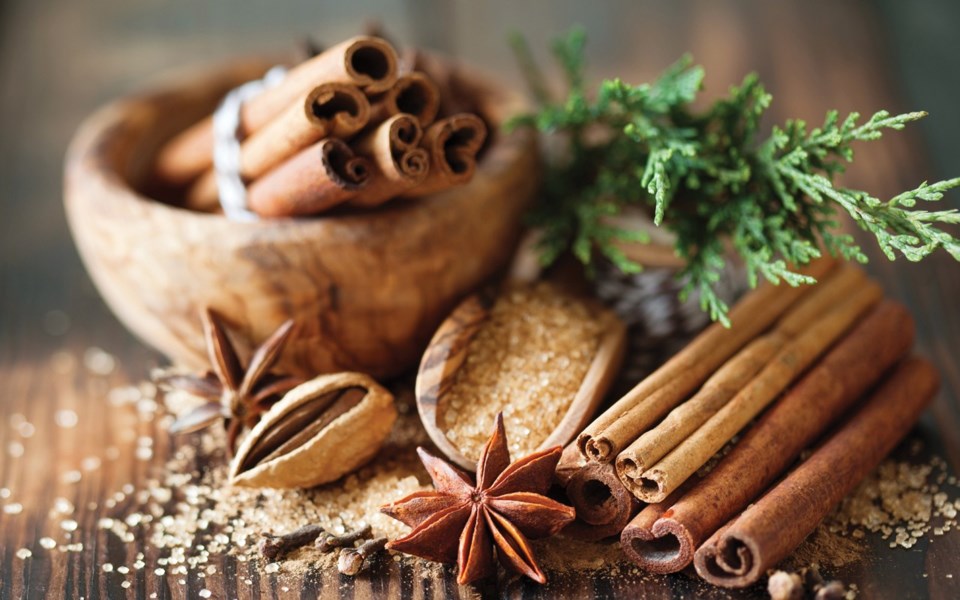Sweet cinnamon. Peppery ginger. Pungent cloves and nutmeg. If there's one thing that says "happy holidays" from your kitchen this time of year, it's the enticement of fragrant spices. Whether they're burbling up from the mulled wine or wafting from the oven as gingerbread men — or angels — spices add magic to our homes and incredible edibles throughout the year, but all the more so during these days of darkest nights.
Spices are amazing but often seriously overlooked, even when they're carefully measured, quarter teaspoon by quarter teaspoon, for a favourite family recipe trotted out each Christmas.
They are as old and storied as civilization itself. The ancient Chen Nong, or Shennong herbal (depending on how the name is transliterated) is supposed to be the basis of Chinese herbal medicine. A mere 5,000 years old, it's said to have helped people move to a diet of plants and grains, along with the help of herbs and spices as medicine. Cinnamon enjoys the first definitive mention of a spice, both in the Bible (Exodus) and in ancient papyruses found in Egypt, although the name we use today is actually from Greek (kynnamomon).
Spices are as political and economic as civilization itself, lying at the root of wars and trade for centuries. As far back as 2000 BC, Pliny and Herodotus recorded that caravans bearing delicious spices and other precious products wound from southern Arabia, bound for Egypt. Alexandria was a great spice centre before it became one for all things intellectual. Persian trade missions were sent to India in the 5th century BCE to bring back ginger. The Dutch-Portuguese War in 1602 was all about spices. And England won the cinnamon war of the 16th century.
Then there are all the romantic, poetic and spiritual ways spices have insinuated themselves into our lives. Aromatic smoke in rituals, including the Catholic church. Fragrant burnt offerings made by priest-kings in King Solomon's time. Spices touted as aphrodisiacs, including that ginger in your gingerbread man! And spice poems for your lover.
But the way spices are so deeply woven into our history, our culture, our lives means that they can also suffer an embarrassment of attention — and worse — in pop culture and glib media, especially this time of year when countless culinary blog sites and lifestyle magazines trot out dross and tired, old (often mistaken) clichés about spices.
I love Maguelonne Toussaint-Samat's first sentence about spices in her classic History of Food, a result of her studies at the École des Hautes Études en Sciences Sociales in Paris. (Thomas Piketty of Capital fame is an alumnus, too.)
"Perhaps more nonsense has been written about spices than any other food product," she writes, citing examples like an Elle magazine article stating that Marco Polo was the first to bring spices to Europe. (Bzzzt! Wrong!)
"It is true that the world of spices, aromatics and condiments is not an easy one to explore, particularly when viewed from a great height," she continues in her poetic style. "Such a symphony of scents rises from it that the head soon swims, and it is difficult to pick out the separate notes in the fragrance." So true in our cooking and baking, too.
So allow me to "pick out" a few more separate notes that might enrich your spice times this holiday season. You can keep them in the back of your mind like little Christmas gems while measuring out that cinnamon and nutmeg. And here we'll take more of a scientific bend, to keep our heads from swimming and avoid those awkward Marco Polo gaffs at the same time.
Spices are often used in cuisines in tropical climates or poor economies to add much-needed vitamins and minerals as much as to add flavouring. Using lots of spices around this time of year could be for the same reason — keeping good health in the dead of winter when food and nutrients along with sunlight (vitamin D) were traditionally sparse. They were also practical for keeping food from spoiling, and tasting like it had, in challenging conditions before refrigeration.
Cinnamon is very high in calcium, iron and magnesium, and pretty good on vitamin C and B6. It's also great for settling the stomach. Half a teaspoon of cinnamon in a cup of tea is an excellent remedy for diarrhea, says Toussaint-Samat — a handy tip in this season of over-indulgence.
Nutmeg is also high in calcium, iron and magnesium as well as potassium and zinc. Cinnamon, cloves, oregano and thyme are all "fairly effective at killing important disease microbes," states Harold McGee in On Food and Cooking. And herbs and spices in general are known for "three broadly helpful tendencies": Their phenolic compounds often display antioxidant activity that can prevent damage to DNA and more. Their terpenes can help reduce the body's production of DNA-damaging molecules that can cause cancer and tumours. And some phenolic compounds and terpenes are useful against inflammation.
As for those gingerbread characters in all their spicy glory, the nice thing about the dough is that you can make and cut your cookies up to a week in advance and store them in the fridge between waxed paper to bring out and bake when you want. There are dozens of recipes online for gingerbread angels, men, houses and more, dusted with sugar crystals or painted with bright icing; made to eat now or to give as ornaments for hanging and eating later.
Have some tasty fun, and in good health!
Glenda Bartosh is an award-winning journalist who is always enchanted by a well-made gingerbread house.




